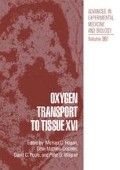Abstract
A multicompartmental model for gas transport in the microcirculation (M.C.M) is a lumped form of the corresponding distributed models. This idea can be understood by the sketch shown in Fig.l. The microcirculation consists of a series of arteriole beds, capillary beds, venule beds and the surrounding tissue, with an oxygen partial pressure distribution and a carbon dioxide partial pressure distribution in both the radial and longitudinal directions. Distributed models, based on either the modified Krogh cylinder or a nonKroghian geometry, usually simulate the radial and axial distributions in one vessel segment or within a local region of the microcirculation. If every vessel group is lumped into a compartment with a unique oxygen partial pressure and a unique carbon dioxide partial pressure, and the tissue is also lumped into one compartment (or more compartments, cf. Ye and Silverton, 1994), then a multicompartmental model is constructed. The model’s block diagram in Fig.1 shows that axial convection of both blood flow and gas occurs along the sequential vessel compartments, and that simultaneous gas diffusions take place between the tissue compartment and every vessel compartment. Thus the global relationship of gas transport and blood supply is quite clear for a M.C.M. It is also easier for a M.C.M to be linked to a global multielement-lumped model for the whole cardiovascular system. Moreover, a compartmental model is described by algebraic equations (for steady-state) or by ordinary differential equations (for time-varying state), whereas a distributed model is described by ordinary differential equations (for one-dimension distributed, steady state) or by partial differential equations (otherwise).
Access this chapter
Tax calculation will be finalised at checkout
Purchases are for personal use only
Preview
Unable to display preview. Download preview PDF.
References
Buerk, D.G., and Bridges, E.W., 1986, A simplified algorithm for computing the variation in oxyhemoglobin saturation with PH, PCO2, T and DPG, Chem. Eng. Comm. 47:113–124.
Buerk, D. G., Shonat, R.D., and Riva, C.E., 1991, Quantifying oxygen losses from retinal arterioles, in “Proceedings of 5th World Congress for Microcirculation”, p.11.
Davies, P.W. and Bronk, D.W., 1957, Oxygen tension in mammalian brain, Federation Proceedings 16: 689–692.
Gleighmann, U., Ingvar, D. H., Liibbers, D. W., Siesjo, B. K., and Thews, G., 1962, Tissue P02 and PCO2 of the cerebral cortex, related to blood gas tensions, Acta Physiol. Scand. 55: 127–138.
Hampson, N.B., Camporesi, E.M., Stolp, B.W., Moon, R.E., Shook, I.E., Griebel, J.A., and Piantadosi, C.A., 1990, Cerebral oxygen availability by NIR spectroscopy during transient hypoxia in humans, J. Appl. Physiol. 69:907–913.
Ivanov, K. P., Derry, A. N., Vovenko, E. P., Samilov, M. O., and Semionov, D. G., 1982, Direct measurements of oxygen tension at the surface of arterioles, capillaries and venules of the cerebral cortex, Pflugers Archv. 393: 118–120.
Lagerlund, T. D., and Low, P. A., 1991, Axial diffusion and Michaelis-Menten Kinetics in oxygen delivery in rat peripheral nerve, Am. J. Physiol. 260: R430–R440.
Nair, P., Whalen, W.J., and Buerk, D., 1975, PO2 of cat cerebral cortex: response to breathing N2 and 100% O2, Microvas. Res. 9: 158–165.
Pittman, R. N., and Duling, B. R.,1977, The determination of oxygen availability in the microcirculation, in “Oxygen and Physiological Function,” F.F.Jobsis, ed., pp. 133–147, Professional Information Library, Dallas.
Popel, A. S., and Gross, J. F., 1979, Analysis of oxygen diffusion from arteriolar network, Am. J. Physiol. 237: H681–H689.
Reneau, D. D., Jr., Duane, D. F., and Knisely, M. H., 1967, A mathematical simulation of oxygen release, diffusion, and consumption in the capillaries and tissue of the human brain, in “Chemical Engineering in Medicine and Biology,” D. Hershey, ed., pp. 135–241, Plenum Press, New York.
Reneau, D. D., Jr., Bruley, D. F., and Knisely, M. H., 1969, A digital simulation of transient oxygen transport in capillary-tissue systems, cerebral grey matter, AIChE Journal 15: 916–925.
Roth, A. C., and Wade, K., 1986, The effects of transport in the microcirculation: a two gas species model, Microvasc. Res. 32: 64–83.
Schacterle, R. S., Adams, J. M., and Ribando, R. J., 1991, A theoretical model of gas transport between arterioles and tissue, Microvasc. Res. 41: 210–228.
Sharan, M., Jones, M. D., Jr, Koehler, R. C., Traystman, R.J., and Popel, A. S., 1989, A Compartmental model for oxygen transport in brain microcirculation, Ann. Biomed. Eng. 17: 13–38.
Swain, D.P., and Pittman, R.N., 1984, Oxygen exchange in the microcirculation of hamster retractor muscle, Abstract, Microvas. Res., 27: 266.
Ye, G-F., 1992, “Theoretical Basis and Computer Realization of a Compartmental Model for O2–CO2 Coupled Transport in the Microcirculation”, Ph.D. dissertation, Drexel University.
Ye, G-F., Moore, T. W., and Jaron, D., 1992a, A compartmental model of oxygen transport derived from a distributed model: treatment of convective and oxygen dissociation properties, in “Proceedings of IEEE 18th Annual Northeast Conference on Bioengineering,” W. J. Ohley, ed., pp. 83–84, Rhode Island.
Ye, G-F., Moore, T. W., Buerk, D.G., and Jaron, D., 1992b, Coupling of oxygen and carbon dioxide transport in a compartmental model of cat brain, in “Program and Abstracts of the Biomedical Engineering Society Third Annual Fall Meeting”, H2.5. Salt Lake City, Utah. [Abstract]
Ye, G-F, Moore T.W., and Jaron, D., 1993, Contributions of oxygen dissociation and convection to the behavior of a compartmental oxygen transport model, Microvasc. Res. 46: 1–18.
Ye, G-F., and Silverton, S. F., 1994, Computer-modeling of oxygen supply to cartilage: addition of a compartmental model, in “Oxygen Transport to Tissue XVI”, M. C. Hogan, O. Mathieu-Costello, D. C. Poole, and P. D. Wagner, eds, Plenum Publishing Co., New York.
Author information
Authors and Affiliations
Editor information
Editors and Affiliations
Rights and permissions
Copyright information
© 1994 Springer Science+Business Media New York
About this chapter
Cite this chapter
Ye, GF. (1994). Formulation and Realization of a Multicompartmental Model for O2-CO2 Coupled Transport in the Microcirculation. In: Hogan, M.C., Mathieu-Costello, O., Poole, D.C., Wagner, P.D. (eds) Oxygen Transport to Tissue XVI. Advances in Experimental Medicine and Biology, vol 361. Springer, Boston, MA. https://doi.org/10.1007/978-1-4615-1875-4_2
Download citation
DOI: https://doi.org/10.1007/978-1-4615-1875-4_2
Publisher Name: Springer, Boston, MA
Print ISBN: 978-1-4613-5763-6
Online ISBN: 978-1-4615-1875-4
eBook Packages: Springer Book Archive

